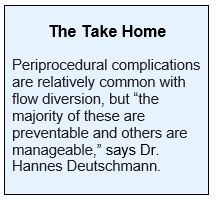Key Points:
- Observational study finds flow diversion has good long-term outcomes
- Periprocedural complications, clinical events seen in approximately one-third of patients
Flow diversion for intracranial aneurysms can produce excellent results, investigators report in a paper published online August 28, 2015, ahead of print in the Journal of NeuroInterventional Surgery. But, they add, clinicians must be prepared to manage perioperative complications and events.
During 100 consecutive procedures, flow diversion was used to treat 95 aneurysms in 93 patients. Rates of mortality and permanent morbidity were low at 1% each, but both periprocedural complications and perioperative clinical events were fairly common at 35% and 28%, respectively.Anthony M. Burrows, MD, of the Mayo Clinic (Rochester, MN), and colleagues prospectively followed 100 patients with intracranial aneurysms who were slated to undergo flow diversion. Outcomes were then analyzed retrospectively.
Periprocedural complications included proximal device migration in 12%, incomplete device expansion in 9%, catheter-induced vasospasm in 6%, and artery perforation from the wire in 3%. The most common perioperative clinical events were thromboembolism and access-site complications, which each affected 6.5% of patients. In addition, worsened extraocular motility occurred in 5 patients (5.4%) but resolved in 4.
During a mean follow-up period of 17 months, no late clinical or technical issues resulting in permanent deficits were uncovered. One patient experienced worsening ataxia. Using what the researchers describe as “very strict angiographic criteria,” complete angiographic obliteration was achieved in 50% of patients at 6 months and 69% after 1 year.
Real-World Information Helpful
“We did not see a trend toward fewer complications over time,” the study authors write. “While this may have been expected as the learning curve was surmounted, this improved technical proficiency took place during increased use of the device for off-label purposes…. [W]hile overall outcomes with flow diversion can be excellent, operators should be aware of and prepared to manage technical issues and clinical events related to flow-diversion treatment.”
In an email with WLNCMD, Hannes Deutschmann, MD, of the Medical University of Graz (Graz, Austria), explained that “there is a significant lack of real-world data [on the use of flow-diverter devices].… We need to know how these devices perform in the everyday patient without the strict inclusion and exclusion criteria [of clinical trials].”
Based on these findings, he said, “the use of flow-diverter devices is effective and, in general, safe, but is associated with a significant number of periprocedural complications. However, the majority of these are preventable and others are manageable.”
Patient Selection Crucial
The key to success, argued Dr. Deutschmann, is appropriate patient selection. “One should treat patients with flow-diverter devices only if there is no other reasonable alternative treatment method.… The proper indication is critical,” he noted.
Additional research is required, Dr. Deutschmann stressed. “First, there should be studies with a clear-cut definition of the indication to treat aneurysms with flow diversion. Only then will it be possible to convince healthcare providers [to use them] and insurance companies to reimburse the procedure,” he noted. “Second, there should be ongoing research to improve the devices. Cases with malpositioning of the stents or periprocedural thrombosis may be prevented if the usability of the devices is improved.”
Source:
Burrows AM, Cloft H, Kallmes DF, et al. Periprocedural and mid-term technical and clinical events after flow diversion for intracranial aneurysms. J NeuroIntervent Surg 2015;7:646–651;Epub ahead of print.
Disclosures:
- Drs. Burrows and Deutschmann report no relevant conflicts of interest.


